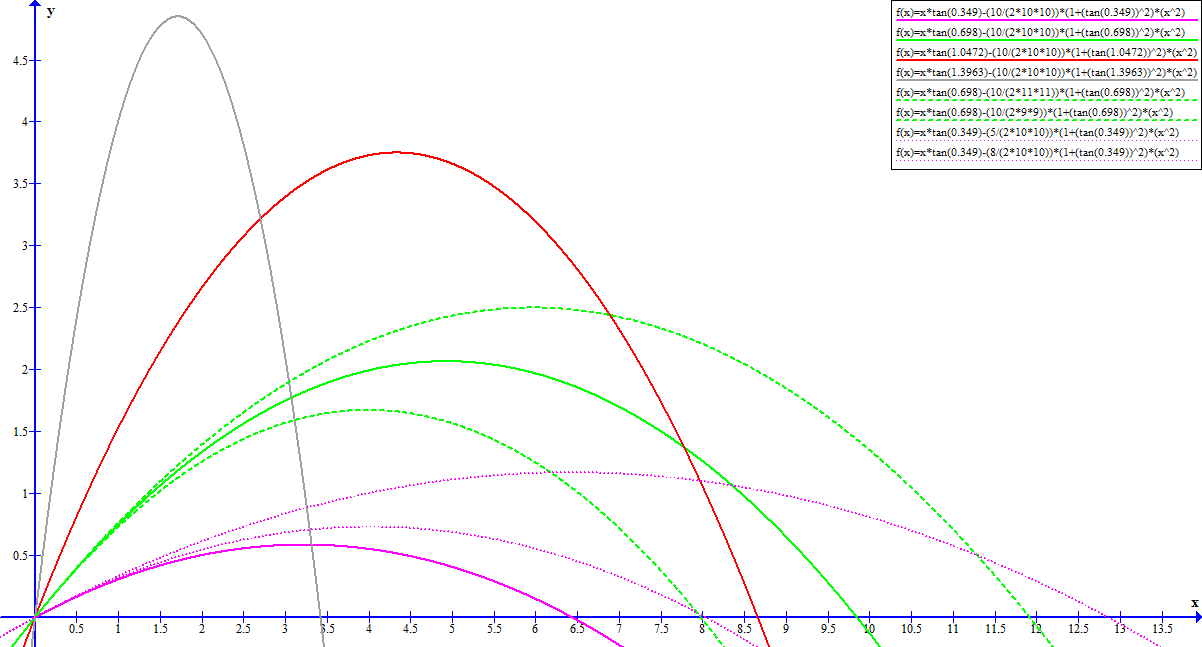Copyright © University of Cambridge. All rights reserved.
'Receding Baseball' printed from https://nrich.maths.org/
Show menu
- A simple example when such a throw happens: throw a ball horizontally.
- Throw a ball vertically up because when it falls down the distance is decreasing.
Suppose the acceleration of gravity is $g$ and initial speeds in horizontal and vertical directions are vx and vy. Lets write the equation of motion in horizontal and vertical directions:
$$x(t) = v_x t\;,$$
$$y(t) = v_y t - \frac{gt^2}{2}\;,$$ where $t$ is the time and x, y are coordinates with $x = 0$ and $ y = 0$ for $t = 0$.
A square of the distance between the pitcher and the ball can be expressed as a function of time:
$f(t) = x(t)^2 + y(t)^2$. Note that a distance is a positive number thus if the distance is always increasing so does the square of the distance. This means we want that a derivative of $f(t)$ would be positive for all $t$.
Plug expressions of x and y into the function and calculate derivative with respect to $t$:
$$f(t) = (v_x t)^2 + \left(v_y t - \frac{gt^2}{2}\right)^2 = (v_x ^2 + v_y ^2)t^2 - g v_y t^3 + \frac{g^2 t^4}{4}\;,$$
$$\frac{df(t)}{dt} = (v_x ^2 + v_y ^2)(2t) - (g v_y)\left(3t^2\right) + \frac{g^2}{4} \left(4t^3\right)$$
because in general if $$f(x) = Cx^{n}$$ where $C$ is a constant and $n$ any real number then $$\frac{df(x)}{dx} = Cnx^{n-1}\;.$$
We want that $\frac{df(t)}{dt} > 0$ for all $t$
$$t\left((v_x ^2 + v_y ^2)(2) - (g v_y)(3t) + \frac{g^2}{4} (4t^2)\right) > 0$$ which means that the discriminant of this quadratic equation must be negative (note that $t > 0$) $\therefore$
$v_y^2 < 8v_x^2$ but $v_x, v_y > 0$. Thus, $\frac{v_y}{v_x} < 2 \sqrt{2}$. If the angle at which the ball is thrown is $\alpha$ then $\tan(\alpha) = \frac{v_y}{v_x}$. Therefore, the only condition for such a throw is that the angle at which the ball is thrown must be less than $\tan^{-1}(2\sqrt(2)) =~ 70.5 °$.
1) It depends on an initial angle, $\alpha < 70.5 °$.
2) It is not dependent on an initial speed of the ball.
3) The condition is the same if we are in the Moon or in the Mars because it does not depend on the acceleration of gravity.
To see why it is not dependent on an initial speed and an acceleration of gravity write the equation of motion in horizontal and vertical directions and get rid of time:
$$y =x \frac{v_y}{v_x} - x^2 \frac{g}{2v_x^2}\;.$$ Moreover, $\tan(\alpha) =\frac{v_y}{v_x}$ and $v_x = v \cos(\alpha)$. We know that $\sin^2 (\alpha) + \cos^2 (\alpha) = 1$. Divide both sides by $\cos^2 (\alpha)$ to get that $\frac{1}{\cos^2 (\alpha)} = 1 + \tan^2 (\alpha)$. Using these identities we get that
$$y =x \tan(\alpha) - x^2 \frac{g}{2v^2}\left (1 + \tan^2 (\alpha)\right)\;.$$
- Green graphs represent trajectories when we change an initial speed
- Violet graphs represent trajectories when we change an acceleration of gravity
- Different colors bold graphs represent trajectories when we change an initial angle

We see that the shape of the parabola is the same if we change an initial speed or an acceleration of gravity.